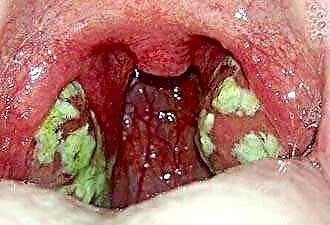Ischemic heart disease (CHD) is one of the most common pathologies of the cardiovascular system. Eating a healthy diet has been shown to lower the risk of developing the disease and, if present, reduce the likelihood of seizures and complications. A diet for angina pectoris reduces weight, normalizes blood pressure, improves metabolism, the objective condition and well-being of patients.
What foods are excluded for angina pectoris?
A patient with an established diagnosis will prevent cardiovascular catastrophe, slow down the progression of atherosclerosis and prevent seizures by limiting the consumption of a number of foods. Nutrition for angina pectoris focuses on lowering blood cholesterol levels.
With ischemic heart disease, it is recommended to limit the following foods:
- fatty fish, poultry, meat;
- Salo;
- butter;
- yolks;
- sour cream;
- cream;
- fast food;
- tripe;
- caviar;
- rich strong broths;
- salinity;
- spicy smoked products.
A hypocholesterol diet minimizes the imbalance of the lipid spectrum and gets rid of extra pounds.
If a patient with angina pectoris is obese, sweet and flour dishes are additionally removed from the diet. Excess weight increases the load on the myocardium and dramatically increases the risk of complications of existing cardiovascular diseases (CVD), or provokes their debut. You can calculate body mass index online here:
| The degree of risk of CVD from the severity of obesity with t. BMI and waist circumference | |||
|---|---|---|---|
| BMI, kg / m2 | Characteristic of body weight | Waist circumference | |
| men <102 cm; women <88 cm | men> 102 cm; women> 88 cm | ||
| Less than 18 | Deficiency W | ||
| 18,5-24,9 | Normal W | ||
| 25,0-29,9 | Excess W | Increased | High |
| 30,0-34,9 | Mild obesity | High | Very tall |
| 35,0-39,9 | Moderate obesity | Very tall | Very tall |
| 40 and more | Severe obesity | Extremely high | Extremely high |
Fasting days (after consultation with a cardiologist):
- apple - up to a kilogram of apples per day;
- cottage cheese - half a kilogram in natural form, cheese cakes, casserole without sauces and gravy;
- dairy - up to a liter of low-fat milk for eight doses per day.
Diet composition
Nutrition for angina pectoris is to minimize the following elements:
- proteins and carbohydrates;
- sodium chloride (high salt concentrations contribute to water retention in the body);
- foods that cause flatulence;
- the amount of food (it is better to eat five to six times a day in small portions);
- animal fats and extracts;
- sugar.
A patient with coronary artery disease needs not only to eat according to an individual menu, but also to give up alcohol. The opinion that alcohol dilates blood vessels, thereby preventing myocardial infarction, has not been proven. On the contrary, excessive consumption of hard liquor provokes sudden death in people with CVD.
The fact is that alcohol has a toxic effect on the myocardium, activating the sympathoadrenal system. As a result, the level of catecholamines increases, which cause spasm of the coronary vessels and arrhythmias.
Limit salt intake, since its excess provokes fluid retention in tissues, including in the walls of blood vessels, narrowing their lumen. It is extremely important to minimize its intake in the body with angina pectoris with arterial hypertension.
Patients are advised to enrich their diet with the following foods:
- seafood rich in unsaturated fatty acids;
- dietary fiber (vegetables and fruits);
- with vitamins C and B (citrus fruits, cabbage, greens);
- lipotropic substances (beef, sea fish);
- trace elements (cottage cheese);
- linoleic acid.
Indicative menu for the week:
- breakfast - porridge, tea;
- lunch - lean chicken with vegetable salad, banana or baked apple;
- lunch - peasant soup, steamed cutlet, pasta or baked potatoes, dried fruit compote or berry jelly;
- afternoon tea - herbal tea or rosehip, fruit or dried apricots / raisins / dates, walnuts;
- dinner - cottage cheese casserole, scrambled eggs, stewed fish with vegetable stew (optional), tea;
- before going to bed - low-fat kefir or fermented baked milk.
The main methods of cooking are stewing, boiling in water and steaming. Food is taken four to six times a day. The temperature of the dishes is normal. Restriction of fried foods is shown. Vegetables and fruits with coarse fiber (up to half a kilogram per day) are boiled, chopped with a blender. Introduce a lot of fresh herbs.
One or two eggs per week, hard-boiled or in a bag, are acceptable. Yesterday's bread rye, Borodino or coarse grinding. Rolls and baked goods are limited. Meat products are brought up to three hundred grams per day. It is allowed to consume coffee drinks diluted with milk.
The diet for angina pectoris includes various leafy vegetables (cabbage, spinach, fennel, Swiss chard) and unsweetened fruits to remove excess cholesterol.
How does diet affect the course of the disease?
Nutritional therapy is a process designed to meet the patient's physiological needs for nutrients, and a method of therapy that affects the pathogenesis of the disease.
Angina pectoris treatment has two goals:
- improved prognosis, prevention of myocardial infarction, decrease in sudden mortality;
- minimizing the frequency of seizures and improving the patient's quality of life.
The main risk factors for the disease include an imbalance of lipid metabolism (increased cholesterol and low density lipoprotein levels), diabetes mellitus, obesity and arterial hypertension.
The therapeutic effect of diets is achieved through the modification of the qualitative composition of food, the balance between substances within the physiological norm, and methods of cooking.
Products and content in them of substances necessary for patients with coronary artery disease:
- B vitamins - all dark cereals, meat, cereals;
- potassium and magnesium - dried fruits, honey, bananas;
- vitamins PP, A, E - vegetable oils;
- iodine - all seafood;
- calcium, iron, copper - dairy products, apples, herbs.
The main task of diet therapy in IHD is to reduce the concentration of plasma cholesterol. In theory, with the help of a balanced diet, it is achieved to reduce it by 10-15 percent.
The main nutritional reasons for the progression of atherosclerosis:
increased energy value of food in combination with physical inactivity;
- the prevalence of animal fats and proteins;
- excess carbohydrates;
- increased use of TCA and LDL cholesterol;
- deficiency of vegetable oils;
- lack of dietary fiber;
- a minimum of lipotropic substances in food;
- restriction of vitamins and folic acid;
- poor diet with electrolytes (an additional factor in the development of vasospastic angina);
- excess salt;
- irregularity and abundance of food;
- alcohol.
Taking into account the influence of nutrition on the development of pathology, the introduction of dietary prescriptions is considered one of the main methods of treatment.
The principles of diet therapy for angina pectoris:
- with a BMI over 30 kg / m2 - reduction of calorie intake to 1400-1600 kcal per day;
- control of fat content;
- total / refined carbohydrate content - seven to one;
- providing vegetable / animal protein at least one to one;
- balance of the food set for vitamins, micro- and macroelements;
- correct preparation of dishes;
- frequent food intake.
Conclusions
Each patient with ischemic heart disease should receive from a dietitian a reminder about a balanced diet, or independently determine their own diet in the manner of specialized therapeutic diets.
The dietary table for ischemia improves the functioning of the circulatory and cardiovascular systems. It is an essential tool in the prevention of myocardial attacks and infarction.



